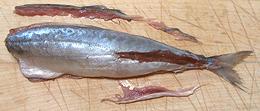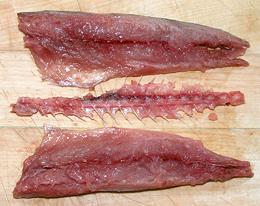
Pan dressed Shortfin Scad
with fins removed.

Fillets of Shortfin Scad, just
pulled off the backbone.
This fish is definitely not "white and light", but for those of us who actually like fish, it has a good combination of taste and texture. Raw the flesh is extremely tender, but cooked it is firm, but flakes apart easily. It is a small fish, but quite meaty.
IF
your fish are under 7 inches long (TL) they are excellent for frying whole. They have a strong enough flavor to be interesting hot or cold, and, while the head and backbone are too hard to eat, it has no bone or fin problems otherwise. In this small size, see our article Dealing with Tiny Fish where full instructions will be found - and that page features this very fish.IF
your fish are over 7 inches long, you can follow the instructions below.Buying: I have found these frozen, from Vietnam, in one of the large Asian markets here in Los Angles (Alhambra). They were labeled "Layang Scad", packed 9 to a bag, 7 to 8-3/4 inches long and up to 3-7/8 ounces. I have also found them on ice in a Philippine market (Eagle Rock) wild caught in California, 6-1/2 inches and weighing 2 ounces.
Scales: This fish is kosher, but you have to be a hungry rabbi with sharp eyes to find any scales - I never have.
Skin: The skin on this fish has so little shrink you can toss a skin-on fillet into poaching water and it will barely curve (from top to bottom). The skin is thin and delicate, as is the flesh it's holding together, so I don't recommend attempting to skin this fish.
Pan Dressing & Filleting:
This is not a difficult fish to work with, but you need a razor sharp filleting knife and a sharp pare of kitchen shears.First
: Cut away the Scutes, it's easiest now. Make a shallow cut through the skin on both sides of the scutes for the part that's straight. When they curve upward they are too small to bother with. Get the point of you filleting knife under the line of scutes and pull it up as you shave them off.- Unless you want to cook this fish head-on, just cut the head off with kitchen shears, down behind both pectoral and pelvic fins.
- Cut the belly open from the vent forward (vent to under the chin if head-on). Scoop out all the innards and rinse. If head-on you will need to pull the gills with long nose pliers, and pull out anything else you find in the head.
- At this point you can easily find all the thin rib bones in the body cavity and pull them out. They will give little resistance.
- Make a fairly deep cut on each side of the dorsal fins for the full length. Pull out the dorsal fins and do the same for the anal fins. This is not done for most small fish, which have fins easily removed after cooking - but this one hides its fins in a groove, making them hard to find and remove.
- You are now just moments from having fillets, so it just depends on how you want to serve your fish: pan dressed or fillets.
- To Fillet, forget your filleting knife - just use your fingers to pull the tender fillet off the backbone.
- You will see a row of centerline pin bones. For fillets I usually pull a few at the front with long nose pliers, its so easy - but I find they have pretty much disappeared in any form of cooking and aren't even noticed in a pan dressed fish.
Frying:
Lightly powder fillets or pan dressed fish with rice flour to prevent sticking. Fillets - first fry skin side up. When half done, flip over. Skin shrink is not a problem.Poaching:
Skin shrink is so weak you can poach skin-on fillets with so little curl (top to bottom) it is not a problem. If poaching pan dressed fish, there will be no noticeable shrink at all.Yield: This is a fairly meaty fish so yield is decent. Fish averaging 8-1/2 inches (TL) yielded 1.88 ounces of skin-on fillet (53%). I made no attempt to skin these fillets.
Stock: Scad are considered to have too strong a taste to make a good soup stock, and having pan dressed these fish, I had only heads, so I didn't try making stock.
 [Layang scad (English); Layang, Layang lidi, Layang deles (Malay);
Cá Nuc Thuôn (Viet); Round Scad, Decapterus macrosoma]
[Layang scad (English); Layang, Layang lidi, Layang deles (Malay);
Cá Nuc Thuôn (Viet); Round Scad, Decapterus macrosoma]